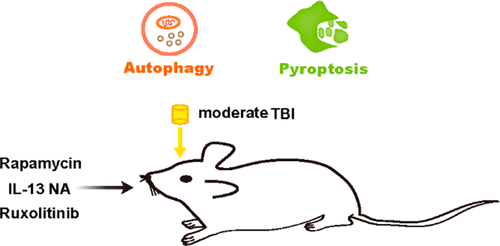当前位置:
X-MOL 学术
›
ACS Chem. Neurosci.
›
论文详情
Our official English website, www.x-mol.net, welcomes your
feedback! (Note: you will need to create a separate account there.)
Autophagy Activation Represses Pyroptosis through the IL-13 and JAK1/STAT1 Pathways in a Mouse Model of Moderate Traumatic Brain Injury
ACS Chemical Neuroscience ( IF 4.1 ) Pub Date : 2020-11-10 , DOI: 10.1021/acschemneuro.0c00517 Cheng Gao 1 , Ya'nan Yan 1 , Guang Chen 1 , Tao Wang 1 , Chengliang Luo 1 , Mingyang Zhang 1 , Xiping Chen 1 , Luyang Tao 1
ACS Chemical Neuroscience ( IF 4.1 ) Pub Date : 2020-11-10 , DOI: 10.1021/acschemneuro.0c00517 Cheng Gao 1 , Ya'nan Yan 1 , Guang Chen 1 , Tao Wang 1 , Chengliang Luo 1 , Mingyang Zhang 1 , Xiping Chen 1 , Luyang Tao 1
Affiliation

|
The newly highlighted research into programmed cell death (PCD), autophagy dependent cell death and pyroptotic cell death, has shown that these processes are both strongly correlated with the pathological progression of traumatic brain injury (TBI). However, their cross-talk in TBI remains unclear. Here, a moderate TBI model was established to explore the relationship between autophagy and pyroptosis. Rapamycin was used to activate the process of autophagy, which was impaired in the moderate TBI model, and this treatment reversed the expression of pyroptosis associated proteins, interleukin-13 (IL-13) and the pJAK-1 pathway, which were upregulated significantly after TBI. The level of IL-13 was downregulated, and the JAK-1 pathway was blocked to reveal the molecular mechanisms by which autophagy inhibits pyroptosis; these two treatments reduced the expression levels of pyroptosis associated proteins. In addition, these three interventions reduced the formation of neuronal NLRP3, the extent of brain edema, and the degree of cortical neuron degeneration. Furthermore, the deficit in motor function post-TBI was also markedly alleviated. Collectively, our results demonstrated that autophagy activation exerts a neuroprotective effect by inhibiting pyroptotic cell death in the moderate TBI model, and the inhibitory effect was dependent on the downregulation of IL-13 and repression of the JAK-1-STAT-1 signaling pathway.
中文翻译:

在中度创伤性脑损伤小鼠模型中,自噬激活通过 IL-13 和 JAK1/STAT1 通路抑制细胞焦亡
新近强调的对程序性细胞死亡 (PCD)、自噬依赖性细胞死亡和细胞焦亡细胞死亡的研究表明,这些过程都与创伤性脑损伤 (TBI) 的病理进展密切相关。然而,他们在 TBI 中的串扰仍不清楚。在这里,建立了一个中度 TBI 模型来探索自噬与细胞焦亡之间的关系。雷帕霉素用于激活在中度 TBI 模型中受损的自噬过程,这种治疗逆转了细胞焦亡相关蛋白白细胞介素 13 (IL-13) 和 pJAK-1 通路的表达,这些蛋白在治疗后显着上调脑外伤。下调IL-13水平,阻断JAK-1通路,揭示自噬抑制细胞焦亡的分子机制;这两种处理降低了细胞焦亡相关蛋白的表达水平。此外,这三种干预措施减少了神经元NLRP3的形成、脑水肿程度和皮质神经元退化程度。此外,TBI 后运动功能的缺陷也明显减轻。总的来说,我们的研究结果表明,自噬激活通过抑制中度 TBI 模型中的细胞焦亡发挥神经保护作用,并且抑制作用依赖于 IL-13 的下调和 JAK-1-STAT-1 信号通路的抑制。脑外伤后运动功能障碍也明显减轻。总的来说,我们的研究结果表明,自噬激活通过抑制中度 TBI 模型中的细胞焦亡发挥神经保护作用,并且抑制作用依赖于 IL-13 的下调和 JAK-1-STAT-1 信号通路的抑制。脑外伤后运动功能障碍也明显减轻。总的来说,我们的研究结果表明,自噬激活通过抑制中度 TBI 模型中的细胞焦亡发挥神经保护作用,并且抑制作用依赖于 IL-13 的下调和 JAK-1-STAT-1 信号通路的抑制。
更新日期:2020-12-16
中文翻译:

在中度创伤性脑损伤小鼠模型中,自噬激活通过 IL-13 和 JAK1/STAT1 通路抑制细胞焦亡
新近强调的对程序性细胞死亡 (PCD)、自噬依赖性细胞死亡和细胞焦亡细胞死亡的研究表明,这些过程都与创伤性脑损伤 (TBI) 的病理进展密切相关。然而,他们在 TBI 中的串扰仍不清楚。在这里,建立了一个中度 TBI 模型来探索自噬与细胞焦亡之间的关系。雷帕霉素用于激活在中度 TBI 模型中受损的自噬过程,这种治疗逆转了细胞焦亡相关蛋白白细胞介素 13 (IL-13) 和 pJAK-1 通路的表达,这些蛋白在治疗后显着上调脑外伤。下调IL-13水平,阻断JAK-1通路,揭示自噬抑制细胞焦亡的分子机制;这两种处理降低了细胞焦亡相关蛋白的表达水平。此外,这三种干预措施减少了神经元NLRP3的形成、脑水肿程度和皮质神经元退化程度。此外,TBI 后运动功能的缺陷也明显减轻。总的来说,我们的研究结果表明,自噬激活通过抑制中度 TBI 模型中的细胞焦亡发挥神经保护作用,并且抑制作用依赖于 IL-13 的下调和 JAK-1-STAT-1 信号通路的抑制。脑外伤后运动功能障碍也明显减轻。总的来说,我们的研究结果表明,自噬激活通过抑制中度 TBI 模型中的细胞焦亡发挥神经保护作用,并且抑制作用依赖于 IL-13 的下调和 JAK-1-STAT-1 信号通路的抑制。脑外伤后运动功能障碍也明显减轻。总的来说,我们的研究结果表明,自噬激活通过抑制中度 TBI 模型中的细胞焦亡发挥神经保护作用,并且抑制作用依赖于 IL-13 的下调和 JAK-1-STAT-1 信号通路的抑制。











































 京公网安备 11010802027423号
京公网安备 11010802027423号